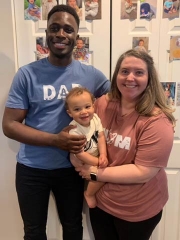Gene Therapy for Sickle Cell Disease: Segun’s Story
Published on
Published on
Segun, 32, was born in Texas, lived briefly in Nigeria as a toddler, and then his family moved to England when he was 5. While it had been suspected that he had sickle cell disease (SCD), it wasn’t until he was around 6 that he received a definitive diagnosis. As the effects of the disease grew increasingly worse, he became more and more concerned about his future — which eventually caused him to make a life-changing decision that brought him to Children's Hospital of Philadelphia (CHOP).
 Segun and his wife, Corinne
When Segun was growing up, he had minor SCD symptoms. “I got tired easier than my peers, but it wasn’t debilitating,” he says. “I played rugby and football and sometimes would cramp up. I didn’t have the endurance and stamina my teammates had, which was sometimes upsetting.” Once when he was 12, he got sick and passed out. At the hospital he was told he should be taking penicillin and folic acid, which he started doing.
Segun and his wife, Corinne
When Segun was growing up, he had minor SCD symptoms. “I got tired easier than my peers, but it wasn’t debilitating,” he says. “I played rugby and football and sometimes would cramp up. I didn’t have the endurance and stamina my teammates had, which was sometimes upsetting.” Once when he was 12, he got sick and passed out. At the hospital he was told he should be taking penicillin and folic acid, which he started doing.
But then, when he reached his 20s, everything changed.
Sickle cell disease affects the red blood cells so that they don’t produce normal hemoglobin. Normal red blood cells are smooth, round and soft, enabling them to move easily through the blood vessels to carry oxygen to all parts of the body. In SCD, the abnormal hemoglobin causes the red blood cells to become hard, pointed and sticky and shaped like crescents or sickles. As a result, they often get stuck when moving through the small blood vessels, causing blockages. The damaged vessels become scarred, narrowed and sometimes completely closed. The blockage of blood flow can lead to pain, organ damage, and even stroke.
In 2010, Segun moved to the United States, and in 2017, he had his first significant pain crisis. “This was different than anything before,” he says. “I had pain in both knees, my elbows and hips. It was a pulsating pain, and it didn’t go away.” He drove himself to an emergency room and told them he had sickle cell disease. “They said I needed to be admitted and hooked up to an IV. It was jarring.”
From that time on, he began having serious pain crises two or three times a year, along with frequent minor episodes. “I became very hyper-aware of my physical activity and avoiding dehydration,” he remembers. “It affected the quality of my life and my mental health. I had a looming fear of what could happen in the future.”
At the sickle cell clinic where he received regular care, he heard about something new: a first-of-its-kind experimental cellular gene therapy that utilizes CRISPR gene-editing technology. It could enable people with SCD to make a normal form of hemoglobin, so the red blood cells no longer become sickle-shaped. He wasn’t sure he wanted to be a part of it — until he had a severe crisis in April 2020. During this episode, he developed acute chest syndrome, a lung-related complication of SCD that creates a pneumonia-like illness. “I was isolated in the hospital because of COVID,” he says. “It was an awful experience.”
Segun decided to pursue getting enrolled in the experimental gene therapy trial, and he contacted CHOP, one of the sites for the clinical trial. He was told he was eligible. “It was daunting,” he admits. For the therapy, bone marrow stem cells are extracted from patients and edited in a lab so that they produce normal hemoglobin. They are then infused back into the body, but first, the patient must undergo chemotherapy to “make space” in the bone marrow for the edited stem cells. The process is essentially a bone marrow transplant, but using the patient’s own cells, which makes the procedure safer for the patient. “It sounded very intense. They explained all the potential side effects and the chances they could happen. That was helpful, but it’s still chemotherapy. You’re voluntarily doing chemotherapy.”
Segun decided to proceed and had his stem cells collected July 2021. Then he was admitted to the Cell Therapy and Transplant Section at CHOP in November for five weeks, during which his wife, Corinne, stayed by his side day and night. “Chemo was the most difficult part of the whole thing,” he says. Once that began, he thought to himself, “I’m in this now. I have to power through and have faith in the doctors. And they made sure I felt secure and informed.”
 Segun and Corinne with their son, Elliot
That faith was rewarded. Since receiving the therapy, he hasn’t had a single pain crisis, and his hemoglobin level, which used to be around 8, is now a normal 15. “It’s been amazing. My mindset is so different — it’s like getting a second chance at life.” The therapy was developed by Vertex and CRISPR Therapeutics, and on Dec. 8, 2023, was approved for use by the U.S. Food and Drug Administration, with the brand name CASGEVY™. It is the first FDA-approved therapy based on the Nobel Prize-winning CRISPR technology.
Segun and Corinne with their son, Elliot
That faith was rewarded. Since receiving the therapy, he hasn’t had a single pain crisis, and his hemoglobin level, which used to be around 8, is now a normal 15. “It’s been amazing. My mindset is so different — it’s like getting a second chance at life.” The therapy was developed by Vertex and CRISPR Therapeutics, and on Dec. 8, 2023, was approved for use by the U.S. Food and Drug Administration, with the brand name CASGEVY™. It is the first FDA-approved therapy based on the Nobel Prize-winning CRISPR technology.
On the same day, another type of therapy for sickle cell disease was also approved by the FDA. Called LYFGENIA™, that product is manufactured by bluebird bio and uses a cell-based gene therapy.
Six months after finishing the therapy, Segun had a son, Elliot. “I had been told many times the statistic about the mortality rate,” he notes. “Some people with sickle cell only make it to their 40s or 50s. Now I know I’m going to be there for my wife and son long-term.”